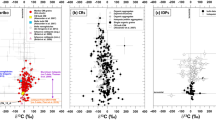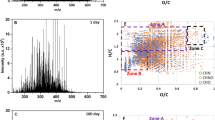Abstract
CHONDRULES are millimetre-sized spheroidal bodies composed mainly of olivine and orthopyroxene, which comprise the dominant fraction of most chondritic meteorites. They are the products of partial melting of aggregates of fine-grained silicates with minor contributions from metals, sulphides and oxides. Although the formation conditions of chondrules are not well understood, these are thought to involve a transient melting event in the solar nebula1–3. The ubiquity of reduced carbon in interstellar clouds and primitive meteorites implies that it was also present in the early solar nebula, and may thus have been a potential constituent of chondrule pre-cursor material. We describe here experiments in which carbon and magnesian silicate precursor material of primitive chondrule composition are 'flash-heated' together and then crystallized. The resulting material shows many mineralogical features character-istic of natural chondrules, which are not produced in the absence of carbon4–12. Our results suggest not only that carbon was present in the solar nebula, but also that it played a key role in chondrule formation by creating within the melt a reducing environment that was decoupled from the nebula gas.
This is a preview of subscription content, access via your institution
Access options
Subscribe to this journal
Receive 51 print issues and online access
$199.00 per year
only $3.90 per issue
Buy this article
- Purchase on Springer Link
- Instant access to full article PDF
Prices may be subject to local taxes which are calculated during checkout
Similar content being viewed by others
References
Grossman, J. N., Rubin, A. E., Nagahara, H. & King, E. A. in Meteorites and the Early Solar System (eds Kerridge, J. K. & Mathews, M. S.) 619–659 (Univ. Arizona, Tucson, 1988).
Grossman, J. N. in Meteorites and the Early Solar System (eds Kerridge, J. K. & Mathews, M. S.) 680–696 (Univ. Arizona, Tucson, 1988).
Hewins, R. H. Geochim. cosmochim. Acta 55, 935–942 (1991).
Lofgren, G. E. Geochim. cosmochim. Acta 53, 461–470 (1989).
Lofgren, G. E. & Russell, W. J. Geochim. cosmochim. Acta 50, 1715–1726 (1986).
Lofgren, G. E. & Lanier, A. Geochim. cosmochim. Acta 54, 3537–3558 (1990).
Radomsky, P. M. & Hewins, R. H. Geochim. cosmochim. Acta 50, 3475–3490 (1991).
Connolly, H. C. Jr & Hewins, R. H. Geochim. cosmochim. Acta 55, 2943–2950 (1991).
Hewins, R. H. in Meteorites and the Early Solar System (eds Kerridge, J. K. & Mathews, M. S.) 660–679 (Univ. Arizona, Tucson, 1988).
Connolly, H. C. Jr & Hewins, R. H. Meteoritics 25, 354–355 (1991).
Connolly, H. C. Jr, Hewins, R. H. & Lofgren, G. E. Lunar planet. Sci. Abstr. 24, 329–330 (1993).
Connolly, H. C. Jr, Hewins, R. H. & Lofgren, G. E. Meteoritics 28, 338–339 (1993).
Wood, J. A. in Protostars and Planets II (eds Black, D. C. & Mathews, M. S.) 687–702 (Univ. Arizona Press, Tucson, 1985).
Brearley, A. J. Geochim. cosmochim. Acta 54, 831–850 (1990).
Scott, E. R. D. et al. Proc. Lunar planet. Sci. Conf. Vol 12 B, 513–523 (Pergamon, 1988).
Taylor, G. J. et al. Lunar Planet. Sci. Abstr. 12, 955–956 (1981).
Scott, E. R. D. & Jones, R. H. Geochim. cosmochin. Acta 54, 2485–2502 (1991).
Kerridge, J. F. Geochim. cosmochim. Acta 49, 1707–1714 (1985).
Nagahara, H. Nature 292, 135–136 (1981).
Rambaldi, E. R. Nature 293, 558–561 (1981).
Tsuchiyama, A. & Miyamoto, M. Lunar Planet. Sci. Abstr. 15, 868–869 (1984).
Grossman, L. & Olsen, E. Geochim. cosmochim. Acta 38, 173–187 (1974).
Scott, E. R. D. & Taylor, G. J. J. geophys. Res. Suppl. 88, B275–B286 (1983).
Zanda, B., Bourot-Denise, M., Perron, C. & Hewins, R. H. Science (in the press).
Wood, J. Icarus 6, 1–49 (1967).
Mostefaoui, S. & Perron, C. Lunar Planet. Sci. Abstr. 25, 945–946 (1994).
Johnson, M. Geochim. cosmochim. Acta 50, 1497–1502 (1986).
Hewins, R. H. & Zanda, B. Meteoritics 27, 233 (1992).
Larimer, J. W. Geochim. cosmochim. Acta 50, 1497–1502 (1968).
Author information
Authors and Affiliations
Rights and permissions
About this article
Cite this article
Connolly, H., Hewins, R., Ash, R. et al. Carbon and the formation of reduced chondrules. Nature 371, 136–139 (1994). https://doi.org/10.1038/371136a0
Received:
Accepted:
Issue Date:
DOI: https://doi.org/10.1038/371136a0
This article is cited by
-
Cometary Refractory Grains: Interstellar and Nebular Sources
Space Science Reviews (2008)
Comments
By submitting a comment you agree to abide by our Terms and Community Guidelines. If you find something abusive or that does not comply with our terms or guidelines please flag it as inappropriate.



